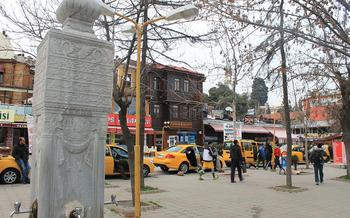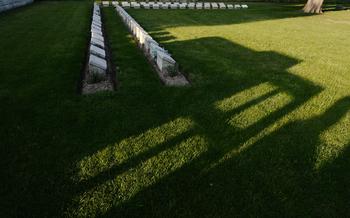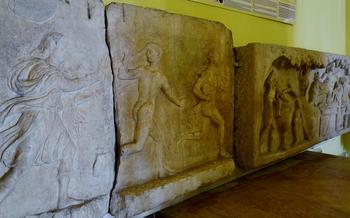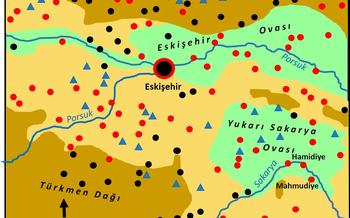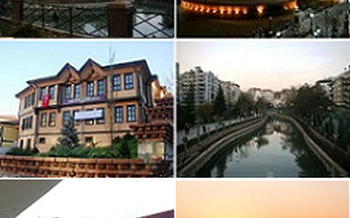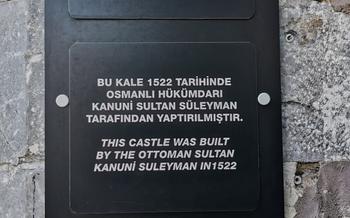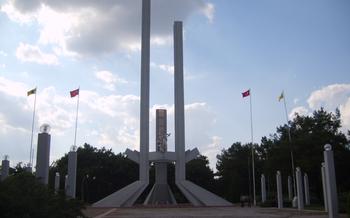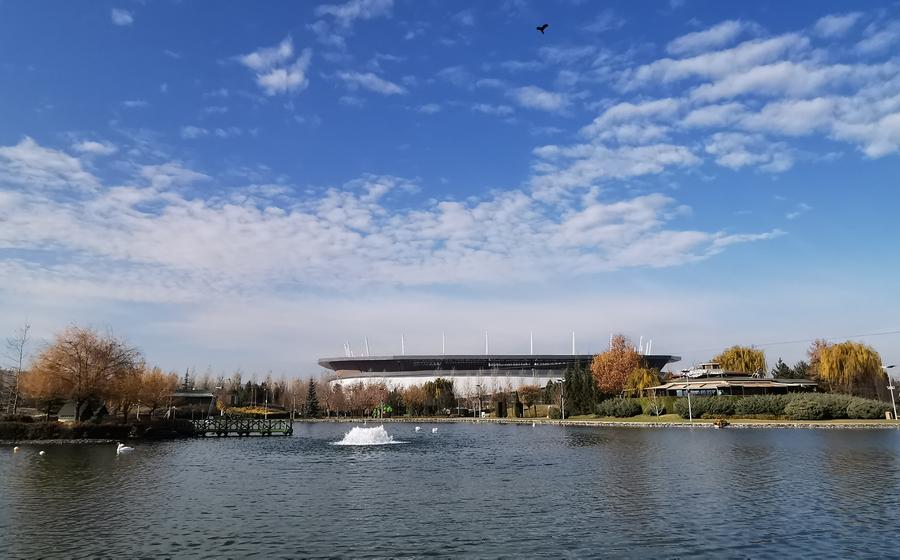
Teskilat i Mahsusa Museum
- The Teskilat i Mahsusa Museum: A Hidden Gem in Eskişehir
- Unveiling the Secrets of the Hidden Organization
- Exploring the Museum's Captivating Exhibits
- Uncovering the Stories of the Teskilat i Mahsusa Agents
- Delving into the Museum's Historical Significance
- A Glimpse into the World of Espionage and Secrecy
- Experiencing the Museum's Interactive Exhibits
- Learning about the Teskilat i Mahsusa's Organizational Structure
- Exploring the Teskilat i Mahsusa's International Connections
- Understanding the Teskilat i Mahsusa's Role in Modern Intelligence
- Reflecting on the Ethical Dilemmas of Espionage
- Appreciating the Teskilat i Mahsusa's Contribution to Turkish History
- Planning Your Visit to the Teskilat i Mahsusa Museum
- Insider Tip: Uncovering Hidden Gems in the Museum
The Teskilat i Mahsusa Museum: A Hidden Gem in Eskişehir
Nestled in the heart of Eskişehir, Turkey, lies a hidden gem that unveils the captivating history of espionage and intelligence in the Ottoman Empire—the Teskilat i Mahsusa Museum. This remarkable institution invites visitors to delve into the world of the Teskilat i Mahsusa, a covert intelligence organization established during the late 19th century that played a pivotal role in shaping the course of Turkish history. Through its collection of rare artifacts, immersive exhibits, and interactive experiences, the museum provides a fascinating glimpse into the clandestine operations and intelligence-gathering activities that defined this enigmatic organization. Prepare to embark on a journey through time as you uncover the secrets of the Teskilat i Mahsusa, an organization that operated in the shadows, leaving an indelible mark on the history of espionage and intelligence.
Unveiling the Secrets of the Hidden Organization
The Teskilat i Mahsusa was a covert intelligence organization established during the Ottoman Empire. It conducted clandestine operations, gathered intelligence, and engaged in espionage activities. The organization's activities were shrouded in secrecy, and its existence was known only to a select few.
The Teskilat i Mahsusa played a significant role in the political and military landscape of the Ottoman Empire. It operated during a time of great turmoil, when the empire was facing internal and external threats. The organization's intelligence-gathering activities were crucial for the empire's decision-making and strategic planning.
The Teskilat i Mahsusa also had international connections. It collaborated with other intelligence agencies and organizations around the world, sharing information and coordinating operations. This collaboration was essential for the empire to stay informed about global events and to protect its interests abroad.
The legacy of the Teskilat i Mahsusa is still felt today. The organization's methods and practices have influenced modern intelligence agencies around the world. The Teskilat i Mahsusa is a reminder of the importance of intelligence gathering and the role it plays in shaping history.
Exploring the Museum's Captivating Exhibits
The Teskilat i Mahsusa Museum houses a treasure trove of historical artifacts, interactive displays, and thematic sections that bring the history of the organization to life. Visitors can marvel at a collection of weapons, uniforms, and personal belongings that provide glimpses into the lives of Teskilat i Mahsusa agents. Interactive exhibits, touchscreens, and multimedia presentations engage visitors and enhance their understanding of the organization's operations.
The museum is organized into different thematic sections, each focusing on a specific aspect of the Teskilat i Mahsusa's history. One section explores the organization's intelligence gathering activities and espionage techniques, showcasing tools and methods used by agents to gather information. Another section highlights the organization's involvement in international conflicts, showcasing artifacts and documents related to its missions during the Balkan Wars and World War I.
Guided tours are available for visitors who seek a deeper understanding of the exhibits. Experienced guides provide in-depth explanations of the artifacts and share anecdotes about the Teskilat i Mahsusa's history, making the museum visit a truly immersive and educational experience.
Uncovering the Stories of the Teskilat i Mahsusa Agents
The Teskilat i Mahsusa Museum not only showcases the history and artifacts of the organization but also brings to life the stories of the brave and dedicated agents who served in its ranks. Through personal narratives, visitors can gain insights into the lives, experiences, and sacrifices of these unsung heroes. The museum highlights the rigorous selection process and specialized training that agents underwent to prepare them for their dangerous missions. It also recounts some of the most notable missions undertaken by Teskilat i Mahsusa agents, showcasing their ingenuity, courage, and effectiveness. These stories of individual agents and their contributions to the organization's success serve as a powerful reminder of the dedication and patriotism that characterized the Teskilat i Mahsusa.
Delving into the Museum's Historical Significance
The Teskilat i Mahsusa Museum serves as a testament to the organization's pivotal role as the Ottoman Empire's primary intelligence-gathering apparatus. During the tumultuous periods of the Balkan Wars and World War I, the Teskilat i Mahsusa played a crucial role in protecting the empire's interests and sovereignty. Its agents engaged in espionage, counterintelligence, and sabotage operations, demonstrating their expertise in the art of covert warfare.
The museum's exhibits shed light on the organization's involvement in international conflicts, highlighting its contributions to the Ottoman Empire's diplomatic and military strategies. Visitors can explore the intricate details of espionage and counterespionage tactics, gaining insights into the shadowy world of intelligence operations.
The Teskilat i Mahsusa's legacy extends beyond its historical significance; it has left an enduring impact on modern intelligence practices and institutions. The museum serves as a valuable resource for scholars, historians, and intelligence professionals seeking to understand the evolution of intelligence work and its role in shaping global events.
A Glimpse into the World of Espionage and Secrecy
The Teskilat i Mahsusa Museum offers a fascinating glimpse into the secretive and clandestine world of espionage. Visitors can learn about the organization's covert operations, intelligence-gathering methods, and counterespionage efforts. The museum showcases a collection of espionage tools and gadgets used by agents, such as hidden cameras, coded messages, and secret writing inks. Interactive exhibits allow visitors to experience the thrill of being a spy, trying their hand at code-breaking and message encryption. The museum also highlights the challenges and obstacles faced by agents during their missions, including enemy surveillance, betrayal, and capture. Through its exhibits and interactive experiences, the Teskilat i Mahsusa Museum provides a unique opportunity to explore the hidden world of espionage and intelligence work.
Experiencing the Museum's Interactive Exhibits
The Teskilat i Mahsusa Museum offers a range of interactive exhibits that bring the history of the organization to life. Multimedia displays, virtual reality experiences, interactive games, and hands-on activities immerse visitors in the world of espionage and intelligence.
Multimedia displays use videos, animations, and interactive maps to illustrate the organization's operations and missions. Visitors can virtually step into the shoes of a Teskilat i Mahsusa agent through virtual reality experiences, simulating the thrill and danger of clandestine operations.
Interactive games and quizzes test visitors' knowledge about the organization and its history, making learning fun and engaging. Hands-on activities allow visitors to try their hand at tasks such as code-breaking and message encryption, providing a glimpse into the skills and techniques used by Teskilat i Mahsusa agents.
These interactive exhibits not only enhance visitors' understanding of the Teskilat i Mahsusa's history but also create a memorable and engaging museum experience.
Learning about the Teskilat i Mahsusa's Organizational Structure
The Teskilat i Mahsusa was a highly structured organization with a clear hierarchy and command structure. At the helm was the Chief of Operations, who reported directly to the Ottoman Ministry of War. Beneath the Chief of Operations were several departments, each responsible for a specific aspect of the organization's work. The Intelligence Department was responsible for gathering and analyzing intelligence, while the Operations Department planned and executed missions. The Training Department was responsible for recruiting and training new agents, and the Logistics Department provided logistical support for missions. Each department was headed by a director who reported to the Chief of Operations.
The Teskilat i Mahsusa also had a number of regional branches, each of which was responsible for a specific geographic area. The branches were headed by regional directors who reported to the Chief of Operations. The regional branches were responsible for carrying out missions in their respective areas and for coordinating with other branches to ensure that operations were executed smoothly and effectively.
Exploring the Teskilat i Mahsusa's International Connections
The Teskilat i Mahsusa was not just a domestic intelligence organization; it also had a significant international presence and collaborated with various intelligence agencies and organizations around the world. These alliances and partnerships were crucial for information sharing, cooperation, and joint operations. The Teskilat i Mahsusa worked closely with intelligence agencies in countries such as Germany, Austria, and Hungary, exchanging information and coordinating activities of mutual interest. These international connections allowed the organization to expand its reach, gain insights into global developments, and contribute to international security efforts. The Teskilat i Mahsusa's ability to navigate the complex world of international espionage and build strong relationships with foreign counterparts speaks to its professionalism and diplomatic skills.
Understanding the Teskilat i Mahsusa's Role in Modern Intelligence
The Teskilat i Mahsusa's legacy extends far beyond its time, leaving an indelible mark on the development of modern intelligence practices and institutions. Its successes and failures have provided valuable lessons for contemporary intelligence agencies, shaping their approaches to espionage, counterintelligence, and covert operations. The organization's adaptability and ability to navigate complex political landscapes continue to inspire modern intelligence professionals, who face similar challenges in a rapidly evolving world.
The Teskilat i Mahsusa's emphasis on rigorous training, meticulous planning, and collaboration laid the foundation for modern intelligence operations. Its agents were pioneers in the field of human intelligence, demonstrating the effectiveness of cultivating and managing human sources to gather critical information. The organization's success in infiltrating enemy organizations and carrying out covert missions has served as a model for modern intelligence agencies, highlighting the importance of secrecy, deception, and precision in intelligence work.
Despite its successes, the Teskilat i Mahsusa also faced challenges that are still relevant today. The organization struggled to balance the need for secrecy with the need for accountability and oversight. Its close ties to the Ottoman government raised concerns about the potential for political manipulation and abuse of power. These challenges continue to be faced by modern intelligence agencies, which must navigate the complex relationship between national security and democratic values.
The Teskilat i Mahsusa's legacy is a reminder that intelligence work is a complex and multifaceted endeavor, requiring a delicate balance between national security, individual rights, and ethical considerations. By studying the organization's history, modern intelligence agencies can learn from its successes and failures, adapting its lessons to the ever-changing landscape of espionage and intelligence gathering.
Reflecting on the Ethical Dilemmas of Espionage
Espionage and intelligence work inevitably raise complex ethical dilemmas. The Teskilat i Mahsusa was no exception, facing challenges in balancing national security with individual rights and freedoms. Weighing the potential benefits of intelligence gathering against the risks and costs was a constant struggle. The organization had to navigate the delicate task of protecting Turkey's interests while respecting the privacy and rights of its citizens. The ethical considerations involved in espionage are a reminder of the fine line that intelligence agencies must tread, and the Teskilat i Mahsusa's experiences offer valuable insights into these challenges.
Appreciating the Teskilat i Mahsusa's Contribution to Turkish History
The Teskilat i Mahsusa played a pivotal role in shaping Turkish national identity and fostering a sense of pride in the country's history. During a time of great political upheaval, the organization worked tirelessly to protect Turkey's national interests and sovereignty. Their courageous efforts and unwavering dedication helped to preserve the country's rich historical legacy and inspire future generations of Turks. The Teskilat i Mahsusa's contributions to Turkish history are immeasurable, and they continue to be honored and celebrated to this day. Preserving and commemorating the legacy of this remarkable organization is of utmost importance, as it serves as a reminder of the sacrifices made by these unsung heroes in safeguarding Turkey's national heritage.
Planning Your Visit to the Teskilat i Mahsusa Museum
The Teskilat i Mahsusa Museum is conveniently located in the heart of Eskişehir, making it easily accessible by public transportation or private vehicles. Admission fees are affordable, and the museum is open to the public during regular hours, with extended hours on weekends. Guided tours are available upon request and provide an immersive experience with in-depth explanations and anecdotes. The museum offers a range of facilities and amenities to enhance your visit, including a gift shop where you can purchase souvenirs and books related to the Teskilat i Mahsusa. To make the most of your visit, plan enough time to explore the exhibits at your own pace. Taking advantage of the guided tours is highly recommended to gain a deeper understanding of the museum's collection and the history of the organization.
Insider Tip: Uncovering Hidden Gems in the Museum
One of the most exciting aspects of exploring the Teskilat i Mahsusa Museum is the opportunity to uncover a hidden exhibit that is not immediately visible to visitors. This secret exhibit holds a collection of unique artifacts and stories that offer a deeper glimpse into the organization's history and operations.
To find the secret exhibit, visitors should keep an eye out for a small, inconspicuous door tucked away in a corner of the museum. Once inside, they will be transported to a dimly lit room filled with fascinating relics, including rare documents, personal belongings of Teskilat i Mahsusa agents, and even a replica of a secret intelligence base.
The stories behind these artifacts are equally captivating, shedding light on the daring missions and ingenious tactics employed by the organization's agents. Visitors will learn about the challenges they faced, the sacrifices they made, and the impact their work had on the course of history.
Discovering the secret exhibit is like embarking on a treasure hunt within the museum. It adds an element of excitement and exclusivity to the visit, making it a truly memorable experience for those who are curious about the hidden depths of the Teskilat i Mahsusa's legacy.
